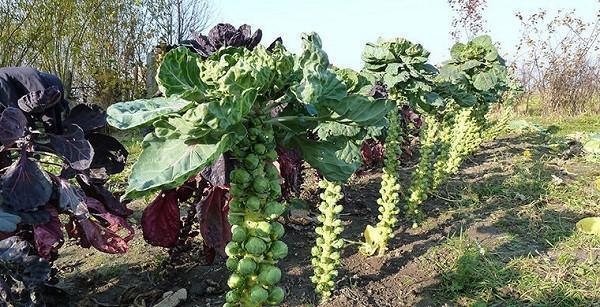Secrets of growing Brussels sprouts
 Brussels sprouts are one of the healthiest varieties of this vegetable garden. In addition to a huge amount of useful vitamins and minerals, it contains protein. Nutritionists assure that the soup from such cabbage in terms of the composition of microelements is equal to chicken broth. Unfortunately, on the beds, a useful tall beauty can not be found so often. Most gardeners are discouraged by the capricious nature of the plant and the features of agricultural technology, not to mention the rather long period from sowing to the ripening of the crop. However, having paid a little attention to the Brussels, it is quite possible to grow small, but so tasty and nutritious heads of cabbage on the site.
Brussels sprouts are one of the healthiest varieties of this vegetable garden. In addition to a huge amount of useful vitamins and minerals, it contains protein. Nutritionists assure that the soup from such cabbage in terms of the composition of microelements is equal to chicken broth. Unfortunately, on the beds, a useful tall beauty can not be found so often. Most gardeners are discouraged by the capricious nature of the plant and the features of agricultural technology, not to mention the rather long period from sowing to the ripening of the crop. However, having paid a little attention to the Brussels, it is quite possible to grow small, but so tasty and nutritious heads of cabbage on the site.
The best way to grow Brussels sprouts is seedling.
For sowing cabbage seeds, you will need a greenhouse or a greenhouse. The seedlings will be there until the time when 4 true leaves are formed on them. Then the seedlings can be dived directly onto the prepared beds. Read also: How to Grow Peking Cabbage?
Soil preparation and planting of seedlings of Brussels sprouts
To grow this kind of cabbage, it is necessary to allocate an illuminated area, but which is at the same time in the "openwork" shade, for example, near large bushes. They will cover plants from direct sunlight, under the influence of which cabbage heads poorly set.
Cabbage beds must be prepared in advance and brought to the site:
- humus;
- wood ash (1 liter of ash per 10 liters of humus).
Seedlings should be planted in a checkerboard pattern, leaving a distance of at least 60 cm between the bushes, since an adult plant takes up quite a lot of space. On acidic soils, add a handful of ash to each hole.
Vegetative period brussels sprouts longer than that of the white cabbage. So that the place in the beds is not empty, you can plant beets between the seedlings.
Planting care
Caring for planted plants includes:
- regular watering:
- weeding and loosening of the soil;
- periodic feeding.
The first feeding can be done 10 days after picking seedlings on the beds, using nitrogen fertilizers. For subsequent dressings, it is good to use herbal infusions and complex mineral fertilizers. In total, 3-4 dressings are enough per season. To prevent the long trunk of the Brussels from falling to one side, after fertilization or watering it is periodically spud.
Experienced gardeners recommend pinching the top of the bush at the start of tying heads of cabbage. Thus, all the forces will be spent on the formation of the crop, and not on the general growth of the plant, and the heads of cabbage themselves will be larger. Although it has been noticed that hybrid varieties are capable of producing a fairly large harvest without this procedure.
As the cabbage grows, its lower leaves turn yellow. They can also be removed.
Harvesting cabbage usually starts at the end of September. In regions with a warm climate, the plant is able to remain in the beds until November, because it perfectly tolerates small frosts (up to 2 degrees below zero). Find out aboutRomanesco cabbage!